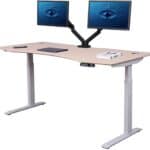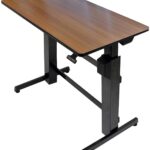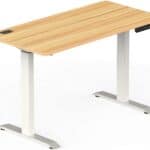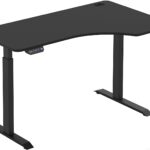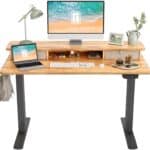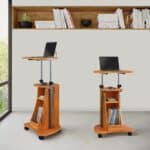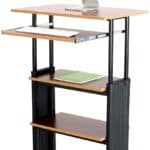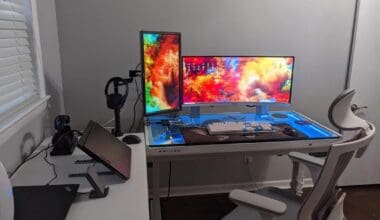Standing desks are pretty famous for their ergonomic benefits and features. However, Standing desk sizes are often overlooked due to their adjustable features.
You must choose the standing desk size, height, weight, and depth according to your height and work requirements.
In this article, let me share what I have researched on the standing desk dimensions to choose the perfect desk size for you.
Table of Contents Show
What Size Standing Desk Should I Get?
Office furniture like desks and chairs are made according to the standard size.
The difference in individuals’ heights makes most industry-standard-size furniture unsuitable for us.
It can cause us to slouch and develop back and wrist pain.
Therefore, we must consider the standing desk size, height, width, and depth suitable for us.
1. Standing Desk Height
The tabletop should be at your elbow height when using the standing desk.
At an upright position with your back straight and shoulders upright, your arms should rest comfortably on the standing desk’s surface.
Your eye level should be slightly above the top edge of the screen while looking directly at the screen.
Therefore, desks are made to fit the standard height of about 6 feet.
The standard desk size for seated desks is 29 inches or 73.5 cm per the standard height.
You can calculate the ideal desk height using the calculator.
Desk height for you in cm = Your height (inch) + 1
Another way you can find your standing desk height is by using this formula.
First, wear the footwear you will wear while using the desk and measure your height.
- Step 1: Your height in inches/ 2
- Step 2: Result in step 1 – 8.5 inches = Minimum desk height
- Step 3: Result in step 2 – 6 inches = Maximum desk height
The standing desk height is not a problem if your height falls upon the adjustable range of the adjustable standing desk.
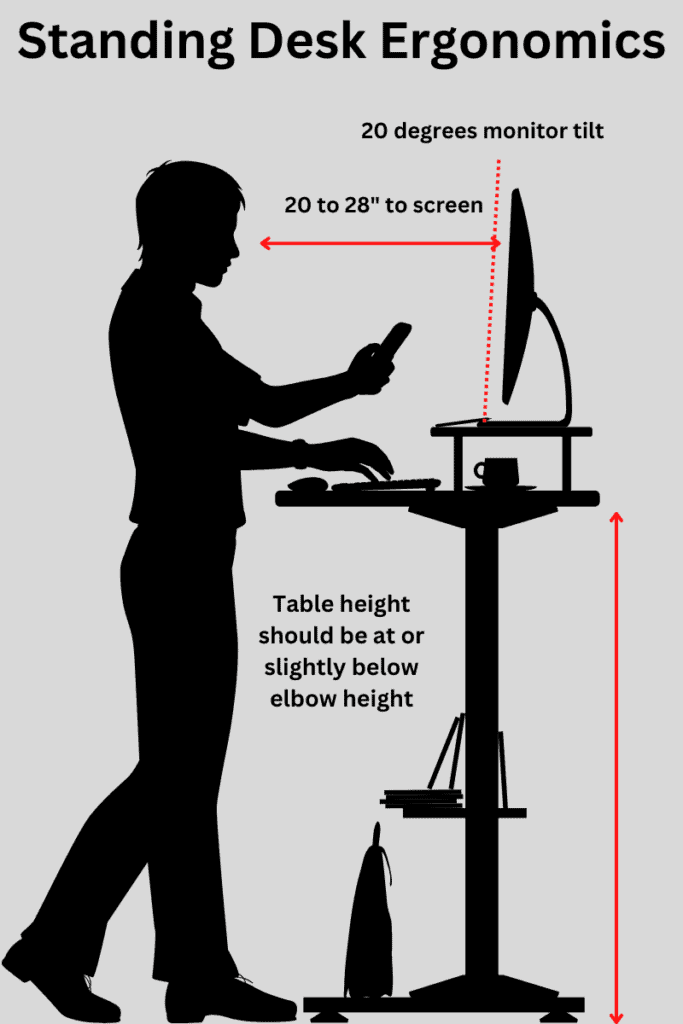
However, if you have a fixed standing desk, you must find a suitable height beforehand.
The tables below will serve as a height guide for you.
| User height (feet/cm) | Desk height while seated (feet) | Desk height while standing (feet) |
|---|---|---|
| 5 ft or 153 cm | 24.2 | 36.5 |
| 5 ft 1 inch or 155.5 cm | 24.6 | 37 |
| 5 ft 2 inches or 158 cm | 25 | 37.5 |
| 5 ft 3 inches or 160.5 cm | 25.4 | 38 |
| 5 ft 4 inches or 163 cm | 25.8 | 39 |
| 5 ft 5 inches or 165.5 cm | 26.2 | 39.5 |
| 5 ft 6 inches or 168 cm | 26.6 | 40.5 |
| 5 ft 7 inches or 170.5 cm | 27 | 41 |
| 5 ft 8 inches or 173 cm | 27.4 | 41.5 |
| 5 ft 9 inches or 175.5 cm | 27.8 | 42.5 |
| 5 ft 10 inches or 178 cm | 28.2 | 43 |
| 5 ft 11 inches or 180.5 cm | 28.6 | 43.5 |
| 6 ft or 183 cm | 29 | 44 |
| 6 ft 1 inch or 185.5 cm | 29.4 | 44.5 |
| 6 ft 2 inches or 188 cm | 29.8 | 45.5 |
| 6 ft 3 inches or 190.5 cm | 30.2 | 46 |
| 6 ft 4 inches or 193 cm | 30.6 | 47 |
| 6 ft 5 inches or 195.5 cm | 31 | 47.5 |
| 6 ft 6 inches or 198 cm | 31.5 | 48 |
| 6 ft 7 inches or 200.5 cm | 31.9 | 49 |
| 6 ft 8 inches or 203 cm | 32.3 | 49.5 |
| 6 ft 9 inches or 205.5 cm | 32.7 | 50 |
| 6 ft 10 inches or 208 cm | 33.1 | 50.5 |
| 6 ft 11 inches or 210.5 cm | 33.5 | 51 |
Problems With a Too-Low Standing Desk
If the standing desk is too short for you, it can cause strain on your back due to excessive slouching.
In addition, using a standing desk at an incorrect height can cause musculoskeletal problems.
Studies show that slouching for a long time can also misalign your spine by straining the muscles and tendons.
You will also need to constantly stretch your arms to reach your keyboard, increasing tension in your arm muscles.
Here are some tips to determine if the standing desk is too low.
- If your back is hunched while typing
- Your arms are stretched out low while reaching the keyboard
- If the monitor is below your eye level
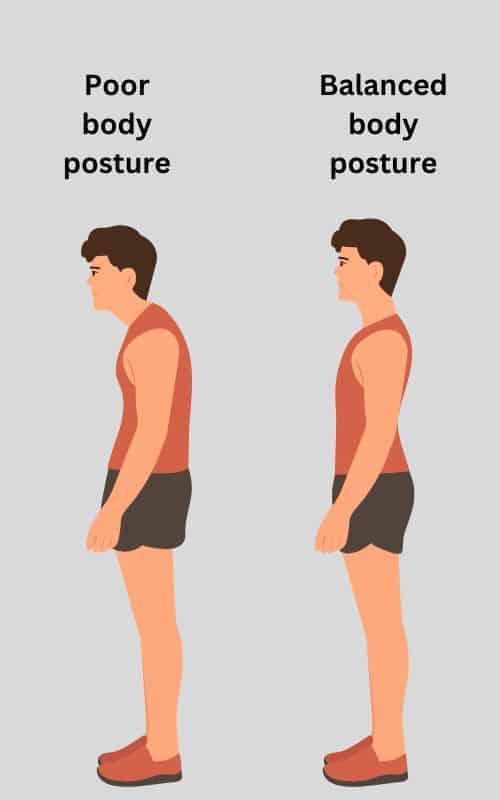
Problems With a Too-High Standing Desk
If your desk is too high, your shoulder will be constantly raised, straining your shoulder and neck muscles and causing excess pain.
You will also need to flex your neck to see the monitor continuously.
Studies show that extending your neck continuously can strain your neck muscles.
Here are some ways to know if the desk is too high for your height.
- If your shoulders are raised while placing your elbows parallel to the desk
- Your elbows are below the level of the desk surface
- You have to stretch your arms more than 90 degrees to reach your keyboard and mouse
How to Find the Perfect Standing Desk Height for Your Height?
- Stand up upright with your back straight.
- Keep your arms at 90 degrees.
- Get a measuring tape and measure the height from the floor to your elbows to calculate the standing height.
- Take a seat in your office chair and measure up to your bent elbows from the floor to calculate seated height.
If you can’t find a standing desk suitable for your height, you can choose an adjustable standing desk and adjust the height accordingly.
2. Standing Desk Width
The standard standing desk width is 48 to 60 inches. However, large standing desks are as wide as 72 inches and as narrow as 40 inches.
Usually, the standard desk width is sufficient for everyone. But depending on your work needs, you might also need a wider standing desk.
For example, if you want to place many desk accessories like printers, lamps, etc., on the desk, you will need a wider space.
Problems With a Narrow Standing Desk
- You will not be able to share the desk with other people.
- You will not have space for many items on your desk, so you might have to continuously get up or stretch your body out to reach for things that can cause strain on your back.
Problems With Too Wide Standing Desk
- Most equipment can be out of the neutral reach zone if your desk is too wide. Studies show that the neutral reach zone reduces strain on your arms muscles and shoulder abduction.
- Having a wider desk can mean uneven distribution of equipment along the desk’s surface, which can cause the desk to wobble.
3. Standing Desk Depth
Standing desks have a minimum of 25 to 30 inches of depth.
Desks with depths less than 20 inches can cause eye strain as the monitor will be closer to the user.
If you share a desk with another person and want to sit facing each other, you should opt for a wider desk at least 40 to 50 inches deep.
Problems With a Too Deep Standing Desk
- The standing desk might be an obstacle while moving around the room.
- If you place your keyboards and mouse too far on the deep-standing desk, your muscles in the arms might be strained due to stretching.
Problems With a Standing Desk That is Not Deep Enough
- Standing desks with less depth are less stable than standing desks with more depth.
- Less deep-standing desks can not comfortably fit multiple monitors like double or triple monitor setups.
- You might be unable to comfortably rest your forearms on the desk for typing due to the narrow space.
Tips to Use Standing Desk Correctly
Here are some tips on using the standing desk correctly.
- The right way to stand at a desk is with your toes pointed forward and your feet fastened to the ground.
- You should also activate your leg muscles and keep your back and neck straight, but not too straight.
- Use an anti-fatigue mat while using a standing desk to encourage the movement of feet while standing so that your muscles are not inactive and sore.
- Keep your neck neutral and your wrists straight in front of you by bending your elbows at a 90-degree angle.
- Raise or lower the standing desk, so your forearms parallel the desk surface.
- With straight, relaxed wrists, your hands should float over the keyboard.
- While using a standing desk, the top of the monitor should be slightly below eye level at an angle of 10 to 20 degrees.
- The screen should also be 20 to 28 inches away from your eyes.
- Attach arm support to your desk to prevent shoulder and neck problems.
- Take frequent breaks from standing. Alternate between sitting and standing every two hours.
- Wear comfortable shoes while standing at a desk.
Also, watch this video for more information,
Best Standing Desk in 2025
Here are some ergonomic standing desks in 2025.
Conclusion
Standing desks are designed with typical desk dimensions, which are unsuitable for users of all heights.
Therefore, you must recognize your need for desk size per your work and height.
Always measure your height to the elbow from the floor in seated and standing positions to find the perfect-sized desk.

